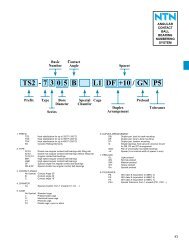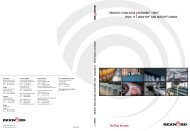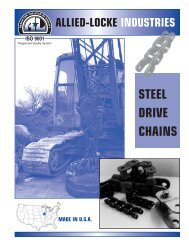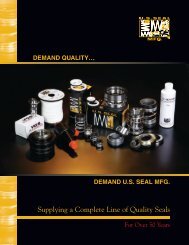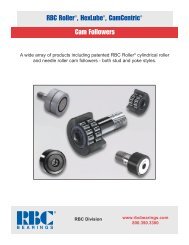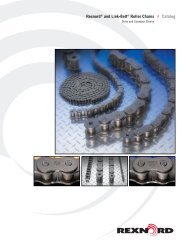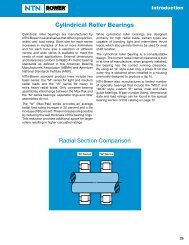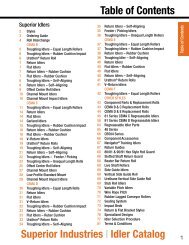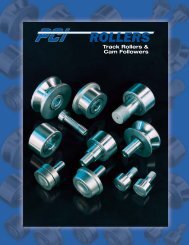- Page 4 and 5: Redi-Seals ®Sealing Solutions Cust
- Page 6 and 7: Redi-Sleeves ®REPAIR DAMAGED SHAFT
- Page 8 and 9: Zero Duplication ProgramKeep lubric
- Page 10 and 11: Using This CatalogCOMPLETE PRODUCT
- Page 12 and 13: SECTION 1-A TECHNICALOIL SEAL DESIG
- Page 14 and 15: SECTION 1-A TECHNICALOIL SEAL DESIG
- Page 16: SECTION 1-A TECHNICALOIL SEAL DESIG
- Page 19 and 20: SECTION 1-B TECHNICALS N E H V APro
- Page 21 and 22: SECTION 1-B TECHNICALS N E H V APro
- Page 23: SECTION 1-B TECHNICALS N E H V APro
- Page 27 and 28: SECTION 1-C TECHNICALSealing System
- Page 30 and 31: SECTION 1-D TECHNICALREDI-SLEEVESGE
- Page 32 and 33: SECTION 1-D TECHNICALV SEALSGENERAL
- Page 34 and 35: OIL SEAL DESIGN TYPESXXIV
- Page 36 and 37: Size SectionHsg.BoreSealO.D.SealWid
- Page 38 and 39: Size SectionHsg.BoreSealO.D.SealWid
- Page 40 and 41: Size SectionHsg.BoreSealO.D.SealWid
- Page 42 and 43: Size SectionHsg.BoreSealO.D.SealWid
- Page 44 and 45: Size SectionHsg.BoreSealO.D.SealWid
- Page 46 and 47: Size SectionHsg.BoreSealO.D.SealWid
- Page 48 and 49: Size SectionHsg.BoreSealO.D.SealWid
- Page 50 and 51: Size SectionHsg.BoreSealO.D.SealWid
- Page 52 and 53: Size SectionHsg.BoreSealO.D.SealWid
- Page 54 and 55: Size SectionHsg.BoreSealO.D.SealWid
- Page 56 and 57: Size SectionHsg.BoreSealO.D.SealWid
- Page 58 and 59: Size SectionHsg.BoreSealO.D.SealWid
- Page 60 and 61: Size SectionHsg.BoreSealO.D.SealWid
- Page 62 and 63: Size SectionHsg.BoreSealO.D.SealWid
- Page 64 and 65: Size SectionHsg.BoreSealO.D.SealWid
- Page 66 and 67: Size SectionHsg.BoreSealO.D.SealWid
- Page 68 and 69: Size SectionHsg.BoreSealO.D.SealWid
- Page 70 and 71: Size SectionHsg.BoreSealO.D.SealWid
- Page 72 and 73: Size SectionHsg.BoreSealO.D.SealWid
- Page 74 and 75:
Size SectionHsg.BoreSealO.D.SealWid
- Page 76 and 77:
Size SectionHsg.BoreSealO.D.SealWid
- Page 78 and 79:
Size SectionHsg.BoreSealO.D.SealWid
- Page 80 and 81:
Size SectionHsg.BoreSealO.D.SealWid
- Page 82 and 83:
Size SectionHsg.BoreSealO.D.SealWid
- Page 84 and 85:
Size SectionHsg.BoreSealO.D.SealWid
- Page 86 and 87:
Size SectionHsg.BoreSealO.D.SealWid
- Page 88 and 89:
Size SectionHsg.BoreSealO.D.SealWid
- Page 90 and 91:
Size SectionHsg.BoreSealO.D.SealWid
- Page 92 and 93:
Size SectionHsg.BoreSealO.D.SealWid
- Page 94 and 95:
Size SectionHsg.BoreSealO.D.SealWid
- Page 96 and 97:
Size SectionHsg.BoreSealO.D.SealWid
- Page 98 and 99:
Size SectionHsg.BoreSealO.D.SealWid
- Page 100 and 101:
Size SectionHsg.BoreSealO.D.SealWid
- Page 102 and 103:
Size SectionHsg.BoreSealO.D.SealWid
- Page 104 and 105:
Size SectionHsg.BoreSealO.D.SealWid
- Page 106 and 107:
Size SectionHsg.BoreSealO.D.SealWid
- Page 108 and 109:
Size SectionHsg.BoreSealO.D.SealWid
- Page 110 and 111:
Size SectionHsg.BoreSealO.D.SealWid
- Page 112 and 113:
Size SectionHsg.BoreSealO.D.SealWid
- Page 114 and 115:
Size SectionHsg.BoreSealO.D.SealWid
- Page 116 and 117:
Size SectionHsg.BoreSealO.D.SealWid
- Page 118 and 119:
Size SectionHsg.BoreSealO.D.SealWid
- Page 120 and 121:
Size SectionHsg.BoreSealO.D.SealWid
- Page 122 and 123:
Size SectionHsg.BoreSealO.D.SealWid
- Page 124 and 125:
Size SectionHsg.BoreSealO.D.SealWid
- Page 126 and 127:
Size SectionHsg.BoreSealO.D.SealWid
- Page 128 and 129:
Size SectionHsg.BoreSealO.D.SealWid
- Page 130 and 131:
Size SectionHsg.BoreSealO.D.SealWid
- Page 132 and 133:
Size SectionHsg.BoreSealO.D.SealWid
- Page 134 and 135:
Size SectionHsg.BoreSealO.D.SealWid
- Page 136 and 137:
Size SectionHsg.BoreSealO.D.SealWid
- Page 138 and 139:
Size SectionHsg.BoreSealO.D.SealWid
- Page 140 and 141:
Size SectionHsg.BoreSealO.D.SealWid
- Page 142 and 143:
Size SectionHsg.BoreSealO.D.SealWid
- Page 144 and 145:
Size SectionHsg.BoreSealO.D.SealWid
- Page 146 and 147:
Size SectionHsg.BoreSealO.D.SealWid
- Page 148 and 149:
Size SectionHsg.BoreSealO.D.SealWid
- Page 150 and 151:
Size SectionHsg.BoreSealO.D.SealWid
- Page 152 and 153:
Size SectionHsg.BoreSealO.D.SealWid
- Page 154 and 155:
Size SectionHsg.BoreSealO.D.SealWid
- Page 156 and 157:
Size SectionHsg.BoreSealO.D.SealWid
- Page 158 and 159:
124Kit DimensionsBoltShaft O.D. Wid
- Page 160 and 161:
Kit DimensionsBoltShaft O.D. Width
- Page 162 and 163:
Eff.ShaftShaft I.D. Dia.128Flanged
- Page 164 and 165:
Shaft RangeWidthMinimum Maximum Par
- Page 166 and 167:
Shaft RangeWidthMinimum Maximum Par
- Page 168 and 169:
Part No.LipMat’lShaftSizeHsg.Bore
- Page 170 and 171:
Numerical List Size & TypePart No.L
- Page 172 and 173:
Numerical List Size & TypePart No.L
- Page 174 and 175:
Numerical List Size & TypePart No.L
- Page 176 and 177:
Numerical List Size & TypePart No.L
- Page 178 and 179:
Numerical List Size & TypePart No.L
- Page 180 and 181:
** * * ***146Part No.LipMat’lShaf
- Page 182 and 183:
Numerical List Size & TypePart No.L
- Page 184 and 185:
Numerical List Size & TypePart No.L
- Page 186 and 187:
Numerical List Size & TypePart No.L
- Page 188 and 189:
Numerical List Size & TypePart No.L
- Page 190 and 191:
Numerical List Size & TypePart No.L
- Page 192 and 193:
Numerical List Size & TypePart No.L
- Page 194 and 195:
Numerical List Size & TypePart No.L
- Page 196 and 197:
Numerical List Size & TypePart No.L
- Page 198 and 199:
Numerical List Size & TypePart No.L
- Page 200 and 201:
Numerical List Size & TypePart No.L
- Page 202 and 203:
Numerical List Size & TypePart No.L
- Page 204 and 205:
Numerical List Size & TypePart No.L
- Page 206 and 207:
Numerical List Size & TypePart No.L
- Page 208 and 209:
Numerical List Size & TypePart No.L
- Page 210 and 211:
Numerical List Size & TypePart No.L
- Page 212 and 213:
Numerical List Size & TypePart No.L
- Page 214 and 215:
Numerical List Size & TypePart No.L
- Page 216 and 217:
Numerical List Size & TypePart No.L
- Page 218 and 219:
Numerical List Size & TypePart No.L
- Page 220 and 221:
Numerical List Size & TypePart No.L
- Page 222 and 223:
Numerical List Size & TypePart No.L
- Page 224 and 225:
Numerical List Size & TypePart No.L
- Page 226 and 227:
Numerical List Size & TypePart No.L
- Page 228 and 229:
Numerical List Size & TypePart No.L
- Page 230 and 231:
Numerical List Size & TypePart No.L
- Page 232 and 233:
Numerical List Size & TypePart No.L
- Page 234 and 235:
Numerical List Size & TypePart No.L
- Page 236 and 237:
Numerical List Size & TypePart No.L
- Page 238 and 239:
Numerical List Size & TypePart No.L
- Page 240 and 241:
Numerical List Size & TypePart No.L
- Page 242 and 243:
Numerical List Size & TypePart No.L
- Page 244 and 245:
Numerical List Size & TypePart No.L
- Page 246 and 247:
Numerical List Size & TypePart No.L
- Page 248 and 249:
Numerical List Size & TypePart No.L
- Page 250 and 251:
Numerical List Size & TypePart No.L
- Page 252 and 253:
Numerical List Size & TypePart No.L
- Page 254 and 255:
Numerical List Size & TypePart No.L
- Page 256 and 257:
Numerical List Size & TypePart No.L
- Page 258 and 259:
Numerical List Size & TypePart No.L
- Page 260 and 261:
Numerical List Size & TypePart No.L
- Page 262 and 263:
Numerical List Size & TypePart No.L
- Page 264 and 265:
Numerical List Size & TypePart No.L
- Page 266 and 267:
Numerical List Size & TypePart No.L
- Page 268 and 269:
Numerical List Size & TypePart No.L
- Page 270 and 271:
Numerical List Size & TypePart No.L
- Page 272 and 273:
Numerical List KitsKit DimensionsSe
- Page 274 and 275:
240Eff.ShaftPart No. Shaft I.D. Dia
- Page 276 and 277:
Eff.ShaftPart No. Shaft I.D. Dia.Fl
- Page 278 and 279:
Part No.Shaft RangeMinimum.Maximum.
- Page 280 and 281:
Part No.Shaft RangeMinimum.Maximum.
- Page 282 and 283:
PartNo.Mat’lCodeStyleShaft SizeMe
- Page 284 and 285:
PartNo.Mat’lCodeStyleShaft SizeMe
- Page 286 and 287:
ShaftSizeHsg.BoreSealO.D.SealWidthL
- Page 288 and 289:
ShaftSize254Hsg.BoreSealO.D.SealWid
- Page 290 and 291:
ShaftSizeHsg.BoreSealO.D.SealWidthL
- Page 292 and 293:
ShaftSizeHsg.BoreSealO.D.SealWidthL
- Page 294 and 295:
ShaftSizeHsg.BoreSealO.D.SealWidthL
- Page 296 and 297:
ShaftSize262Hsg.BoreSealO.D.SealWid
- Page 298 and 299:
ShaftSizeHsg.BoreSealO.D.SealWidthL
- Page 300 and 301:
ShaftSize266Hsg.BoreSealO.D.SealWid
- Page 302 and 303:
ShaftSize268Hsg.BoreSealO.D.SealWid
- Page 304 and 305:
ShaftSize270Hsg.BoreSealO.D.SealWid
- Page 306 and 307:
ShaftSizeHsg.BoreSealO.D.SealWidthL
- Page 308 and 309:
ShaftSize274Hsg.BoreSealO.D.SealWid
- Page 310 and 311:
ShaftSizeHsg.BoreSealO.D.SealWidthL
- Page 312 and 313:
ShaftSizeHsg.BoreSealO.D.SealWidthL
- Page 314 and 315:
ShaftSize280Hsg.BoreSealO.D.SealWid
- Page 316 and 317:
Std.UnitPackWidth ID ODPackagedPart
- Page 318 and 319:
OK 311Designed for emergency mainte
- Page 320 and 321:
A1205L-740 - A1403Mfr. No.286NameZe
- Page 322 and 323:
A1805P-588 - A27415Mfr. No.NameZero
- Page 324 and 325:
A45825K - A46905SMfr. No.NameZero D
- Page 326 and 327:
A53104S - A54285Mfr. No.NameZero Du
- Page 328 and 329:
A54635 - A56252Mfr. No.NameZero Dup
- Page 330 and 331:
A64008 - A76011SMfr. No.NameZero Du
- Page 332 and 333:
A86285S - AA3357E0Mfr. No.NameZero
- Page 334 and 335:
AB1832F0 - AB7345EMfr. No.NameZero
- Page 336 and 337:
AC1824E0 - AD1446E0Mfr. No.302NameZ
- Page 338 and 339:
AD7095E0 - AE0387E0Mfr. No.304NameZ
- Page 340 and 341:
AE37476 - AF8729E0Mfr. No.NameZero
- Page 342 and 343:
AH2093F - AH8888EMfr. No.NameZero D
- Page 344 and 345:
AP-3173 - AR2266F0Mfr. No.310NameZe
- Page 346 and 347:
ATP643 - B132704AAMfr. No.312NameZe
- Page 348 and 349:
B6982 - BD3467E0Mfr. No.314NameZero
- Page 350 and 351:
BH3004E0 - BS86Mfr. No.316NameZero
- Page 352 and 353:
C3AZ3591A - C9TA1175RMfr. No.318Nam
- Page 354 and 355:
D1FZ1177B - D6HZ7B215AMfr. No.320Na
- Page 356 and 357:
DR3465 - DV1612Mfr. No.NameZero Dup
- Page 358 and 359:
E43E6700A2A - E9020310Mfr. No.324Na
- Page 360 and 361:
EX54262ND - F65105Mfr. No.326NameZe
- Page 362 and 363:
GC1115 - GS1371Mfr. No.NameZero Dup
- Page 364 and 365:
HD5586 - JV614Mfr. No.330NameZero D
- Page 366 and 367:
K321299R - K9L8336Mfr. No.NameZero
- Page 368 and 369:
L0090003 - L4040RA1Mfr. No.NameZero
- Page 370 and 371:
L81-6744 - L907087TD0Mfr. No.NameZe
- Page 372 and 373:
M2685A - MA583Mfr. No.338NameZero D
- Page 374 and 375:
MX62601 - NJ132Mfr. No.NameZero Dup
- Page 376 and 377:
NJ709 - P-328Mfr. No.NameZero Dupli
- Page 378 and 379:
P6505 - PR1219Mfr. No.NameZero Dupl
- Page 380 and 381:
PR1937 - PR2502Mfr. No.NameZero Dup
- Page 382 and 383:
PR2986 - PR3588Mfr. No.NameZero Dup
- Page 384 and 385:
PR4795 - PR5201Mfr. No.NameZero Dup
- Page 386 and 387:
PR6002 - PR8017Mfr. No.NameZero Dup
- Page 388 and 389:
PR8834 - RCP71164Mfr. No.NameZero D
- Page 390 and 391:
S129 - S410Mfr. No.356NameZero Dupl
- Page 392 and 393:
SE-63 - SS46841Mfr. No.NameZero Dup
- Page 394 and 395:
T225086 - T65300Mfr. No.NameZero Du
- Page 396 and 397:
TX139 - U81-8771Mfr. No.NameZero Du
- Page 398 and 399:
UH0403F0 - W10652Mfr. No.NameZero D
- Page 400 and 401:
WA7052 - X5704Mfr. No.NameZero Dupl
- Page 402 and 403:
XL34-7052AA - 0009971746Mfr. No.Nam
- Page 404 and 405:
0078-14779LPD - 0137-40000LDSMfr. N
- Page 406 and 407:
0193-16719LDS - 0225-8991LUPMfr. No
- Page 408 and 409:
0300-6073LUP - 0400-9866LUPMfr. No.
- Page 410 and 411:
051815 - 052-3402Mfr. No.NameZero D
- Page 412 and 413:
0521260 - 0562-10152LUPMfr. No.Name
- Page 414 and 415:
0704-1155 - 0704-5600Mfr. No.NameZe
- Page 416 and 417:
0704-7143 - 0704-7480Mfr. No.NameZe
- Page 418 and 419:
0704-7781 - 0704-G844Mfr. No.NameZe
- Page 420 and 421:
0814477 - 100021Mfr. No.NameZero Du
- Page 422 and 423:
10088158 - 1018+320-2104Mfr. No.388
- Page 424 and 425:
103185 - 105067Mfr. No.NameZero Dup
- Page 426 and 427:
107216 - 10933Mfr. No.NameZero Dupl
- Page 428 and 429:
11/2F11564 - 111105245Mfr. No.394Na
- Page 430 and 431:
112190 - 11430Mfr. No.NameZero Dupl
- Page 432 and 433:
116265H1 - 118275Mfr. No.NameZero D
- Page 434 and 435:
119666 - 12075Mfr. No.400NameZero D
- Page 436 and 437:
12304152 - 124310Mfr. No.NameZero D
- Page 438 and 439:
12613 - 129474Mfr. No.NameZero Dupl
- Page 440 and 441:
1311035 - 134717Mfr. No.406NameZero
- Page 442 and 443:
13714 - 139561Mfr. No.NameZero Dupl
- Page 444 and 445:
14096077 - 144A11604Mfr. No.410Name
- Page 446 and 447:
14821LDS - 15-00505Mfr. No.NameZero
- Page 448 and 449:
1501+2102 - 15038700Mfr. No.NameZer
- Page 450 and 451:
1521506 - 15502Mfr. No.416NameZero
- Page 452 and 453:
15580226 - 15781Mfr. No.NameZero Du
- Page 454 and 455:
16-5625-8 - 1610095Mfr. No.420NameZ
- Page 456 and 457:
1634217 - 166-102Mfr. No.NameZero D
- Page 458 and 459:
1690190BM - 1712+2711Mfr. No.424Nam
- Page 460 and 461:
17314M1 - 17614Mfr. No.NameZero Dup
- Page 462 and 463:
17950 - 18312M1Mfr. No.428NameZero
- Page 464 and 465:
18689 - 18F681D117Mfr. No.NameZero
- Page 466 and 467:
18F681D38 - 18F682D297Mfr. No.NameZ
- Page 468 and 469:
1909851 - 194146Mfr. No.434NameZero
- Page 470 and 471:
19618 - 199417Mfr. No.NameZero Dupl
- Page 472 and 473:
1K6983 - 20004Mfr. No.NameZero Dupl
- Page 474 and 475:
20160 - 2040H26Mfr. No.NameZero Dup
- Page 476 and 477:
206364TA - 2083Mfr. No.NameZero Dup
- Page 478 and 479:
210737R91 - 21086-2546Mfr. No.NameZ
- Page 480 and 481:
21086-3190 - 211Mfr. No.NameZero Du
- Page 482 and 483:
21149 - 21158-0761Mfr. No.NameZero
- Page 484 and 485:
21158-1479 - 21158-3876Mfr. No.Name
- Page 486 and 487:
21158-6446 - 21158-7165Mfr. No.Name
- Page 488 and 489:
21158-8266 - 2116298Mfr. No.NameZer
- Page 490 and 491:
21281 - 21527-1660Mfr. No.NameZero
- Page 492 and 493:
21661 - 217570Mfr. No.NameZero Dupl
- Page 494 and 495:
220230 - 22322VAYMfr. No.NameZero D
- Page 496 and 497:
225084 - 227160075Mfr. No.NameZero
- Page 498 and 499:
230106 - 233-S443173945Mfr. No.Name
- Page 500 and 501:
236629 - 24012408Mfr. No.NameZero D
- Page 502 and 503:
2439186 - 24814004Mfr. No.468NameZe
- Page 504 and 505:
250124 - 25354SAMfr. No.NameZero Du
- Page 506 and 507:
258511FF - 26186Mfr. No.NameZero Du
- Page 508 and 509:
26303 - 268630915Mfr. No.NameZero D
- Page 510 and 511:
273580R91 - 276W128-M1Mfr. No.NameZ
- Page 512 and 513:
284112M1 - 28AC203Mfr. No.NameZero
- Page 514 and 515:
291005R91 - 29214Mfr. No.NameZero D
- Page 516 and 517:
293169 - 2951Mfr. No.NameZero Dupli
- Page 518 and 519:
29759X - 298324Mfr. No.NameZero Dup
- Page 520 and 521:
298589 - 29907Mfr. No.NameZero Dupl
- Page 522 and 523:
2A6475 - 3002400Mfr. No.NameZero Du
- Page 524 and 525:
30199 - 30348536Mfr. No.NameZero Du
- Page 526 and 527:
307121 - 31105DMfr. No.NameZero Dup
- Page 528 and 529:
313913R92 - 3180211Mfr. No.NameZero
- Page 530 and 531:
319W35510 - 32380Mfr. No.NameZero D
- Page 532 and 533:
325W128-M1 - 330-3046Mfr. No.NameZe
- Page 534 and 535:
33524810 - 33861Mfr. No.NameZero Du
- Page 536 and 537:
34370 - 34980Mfr. No.NameZero Dupli
- Page 538 and 539:
35137S - 357770R91Mfr. No.NameZero
- Page 540 and 541:
36106 - 364SZ34Mfr. No.NameZero Dup
- Page 542 and 543:
3702255 - 374293Mfr. No.NameZero Du
- Page 544 and 545:
378157R91 - 383332R91Mfr. No.NameZe
- Page 546 and 547:
387W3 - 392-9097Mfr. No.NameZero Du
- Page 548 and 549:
39895 - 400003205Mfr. No.NameZero D
- Page 550 and 551:
400487 - 401469Mfr. No.NameZero Dup
- Page 552 and 553:
405368C91 - 410005Mfr. No.518NameZe
- Page 554 and 555:
41281S - 415991Mfr. No.NameZero Dup
- Page 556 and 557:
42046 - 42419Mfr. No.NameZero Dupli
- Page 558 and 559:
425W34 - 430625Mfr. No.NameZero Dup
- Page 560 and 561:
433 - 43875Mfr. No.NameZero Duplica
- Page 562 and 563:
44180 - 44443Mfr. No.NameZero Dupli
- Page 564 and 565:
447292 - 450226Mfr. No.NameZero Dup
- Page 566 and 567:
450779 - 4519LUPMfr. No.NameZero Du
- Page 568 and 569:
454707C91 - 456026Mfr. No.NameZero
- Page 570 and 571:
46070 - 463024Mfr. No.NameZero Dupl
- Page 572 and 573:
46811 - 47026Mfr. No.NameZero Dupli
- Page 574 and 575:
47110 - 47184Mfr. No.NameZero Dupli
- Page 576 and 577:
473247 - 47477Mfr. No.NameZero Dupl
- Page 578 and 579:
47631 - 47805XMfr. No.NameZero Dupl
- Page 580 and 581:
48035 - 482125Mfr. No.NameZero Dupl
- Page 582 and 583:
486153 - 48806Mfr. No.NameZero Dupl
- Page 584 and 585:
OIL SEALSZero Duplicationor Recomme
- Page 586 and 587:
49848 - 4GE-0618AMfr. No.NameZero D
- Page 588 and 589:
50-303571-00 - 500265Mfr. No.NameZe
- Page 590 and 591:
500601 - 50110SMfr. No.NameZero Dup
- Page 592 and 593:
50184S - 50239SMfr. No.NameZero Dup
- Page 594 and 595:
5030679950 - 504010Mfr. No.NameZero
- Page 596 and 597:
506068 - 5079BMfr. No.NameZero Dupl
- Page 598 and 599:
51007 - 51125Mfr. No.NameZero Dupli
- Page 600 and 601:
5141050 - 517273Mfr. No.NameZero Du
- Page 602 and 603:
51X1272 - 51X204Mfr. No.NameZero Du
- Page 604 and 605:
51X4882 - 51X666Mfr. No.NameZero Du
- Page 606 and 607:
51X7439 - 51X8708Mfr. No.NameZero D
- Page 608 and 609:
52303 - 52X65X9SCMfr. No.NameZero D
- Page 610 and 611:
5374B - 53X2531Mfr. No.NameZero Dup
- Page 612 and 613:
53X3127 - 53X9724Mfr. No.NameZero D
- Page 614 and 615:
5489LPD - 550414M1Mfr. No.NameZero
- Page 616 and 617:
552573 - 558245Mfr. No.NameZero Dup
- Page 618 and 619:
568452 - 575410Mfr. No.NameZero Dup
- Page 620 and 621:
5875 - 5984Mfr. No.NameZero Duplica
- Page 622 and 623:
6002155 - 60322Mfr. No.NameZero Dup
- Page 624 and 625:
606910 - 60G186Mfr. No.NameZero Dup
- Page 626 and 627:
611761 - 61670Mfr. No.NameZero Dupl
- Page 628 and 629:
62224 - 6240SMfr. No.NameZero Dupli
- Page 630 and 631:
625E5 - 62E365Mfr. No.NameZero Dupl
- Page 632 and 633:
63043 - 63392Mfr. No.NameZero Dupli
- Page 634 and 635:
63X109 - 63X1746Mfr. No.NameZero Du
- Page 636 and 637:
63X336 - 63X511Mfr. No.NameZero Dup
- Page 638 and 639:
63X6639 - 63X7291Mfr. No.NameZero D
- Page 640 and 641:
63X8280 - 640545Mfr. No.NameZero Du
- Page 642 and 643:
64656 - 6501364Mfr. No.NameZero Dup
- Page 644 and 645:
65601S - 65X1252Mfr. No.NameZero Du
- Page 646 and 647:
65X2043 - 65X2915Mfr. No.NameZero D
- Page 648 and 649:
65X761 - 6641Mfr. No.NameZero Dupli
- Page 650 and 651:
OIL SEALSZero Duplicationor Recomme
- Page 652 and 653:
OIL SEALSZero Duplicationor Recomme
- Page 654 and 655:
67X213 - 69084Mfr. No.NameZero Dupl
- Page 656 and 657:
70051145 - 70695217Mfr. No.NameZero
- Page 658 and 659:
7186LPD - 72-18860MMfr. No.NameZero
- Page 660 and 661:
72-420900 - 7229Mfr. No.NameZero Du
- Page 662 and 663:
732347 - 74538BMfr. No.NameZero Dup
- Page 664 and 665:
75X95X10SC - 7841AMfr. No.NameZero
- Page 666 and 667:
7K9211 - 80202Mfr. No.NameZero Dupl
- Page 668 and 669:
80527 - 8110371Mfr. No.NameZero Dup
- Page 670 and 671:
825083 - 832332M1Mfr. No.NameZero D
- Page 672 and 673:
84119 - 843844M1Mfr. No.NameZero Du
- Page 674 and 675:
84606 - 84795Mfr. No.NameZero Dupli
- Page 676 and 677:
8516 - 8583Mfr. No.NameZero Duplica
- Page 678 and 679:
8680153 - 88149Mfr. No.NameZero Dup
- Page 680 and 681:
88AX120P3 - 88AX416P2Mfr. No.NameZe
- Page 682 and 683:
8999LPD - 901241155Mfr. No.648NameZ
- Page 684 and 685:
9014017 - 91036Mfr. No.NameZero Dup
- Page 686 and 687:
9156020 - 92204Mfr. No.NameZero Dup
- Page 688 and 689:
93801 - 9450Mfr. No.NameZero Duplic
- Page 690 and 691:
9577A - 9709Mfr. No.NameZero Duplic
- Page 692 and 693:
97GX151 - 97KX222Mfr. No.NameZero D
- Page 694 and 695:
97VX15 - 97X315Mfr. No.NameZero Dup
- Page 696 and 697:
OIL SEALSZero Duplicationor Recomme
- Page 698 and 699:
ABBREVIATIONS TO MANUFACTURERSABBRE
- Page 700 and 701:
Other Quality Industrial ProductsV-




